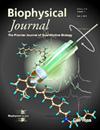Bacteria Can Rotate while Body-Tethered to a Solid Surface.
IF 3.2
3区 生物学
Q2 BIOPHYSICS
引用次数: 0
Abstract
The attachment of bacteria to solid surfaces has been studied primarily through the modes of pili or flagella tethering. We report on a common feature of tethering in pililess strains of three species of monotrichous bacteria-(Vibrio alginolyticus, Pseudomonas aeruginosa, and Caulobacter crescentus)-namely, that they may become tethered to the surface by their cell body rather than by their flagellum. These tethered bacteria rotate in alternating directions about a pivot point located under the cell body. Using high-intensity darkfield microscopy, we observed that, in most cases, the flagellum of a tethered Vibrio alginolyticus rotates together with the cell body. We name this distinct mode of attachment body tethering. Observing hundreds of rotating bacteria tethered to the surface, we find that body tethering is a more common mode of attachment than flagellum tethering for these three strains of bacteria. Our results confirm that body tethering is a key mechanism for the surface attachment of bacteria without pili. Recognizing body tethering as a robust mode of bacterial attachment to surfaces may have broad implications in the study of bacterial adhesion and biofilm formation.细菌可以在身体附着在固体表面时旋转。
人们主要通过纤毛或鞭毛的系留模式来研究细菌对固体表面的附着。我们报告了三种单富集细菌(藻溶弧菌、铜绿假单胞菌和新月芽孢杆菌)的无纤毛菌株系留的一个共同特征,即它们可能通过细胞体而非鞭毛系留在表面。这些被拴住的细菌围绕位于细胞体下方的一个支点交替旋转。我们利用高强度暗视野显微镜观察到,在大多数情况下,系留藻溶弧菌的鞭毛与细胞体一起旋转。我们将这种独特的附着体系留模式命名为 "系留"。通过观察数百个系留在表面的旋转细菌,我们发现对于这三种细菌来说,体系留是比鞭毛系留更常见的附着模式。我们的研究结果证实,体系链是无纤毛细菌表面附着的关键机制。认识到体部系链是细菌附着到表面的一种强有力的模式,可能会对细菌粘附和生物膜形成的研究产生广泛的影响。
本文章由计算机程序翻译,如有差异,请以英文原文为准。
求助全文
约1分钟内获得全文
求助全文
来源期刊

Biophysical journal
生物-生物物理
CiteScore
6.10
自引率
5.90%
发文量
3090
审稿时长
2 months
期刊介绍:
BJ publishes original articles, letters, and perspectives on important problems in modern biophysics. The papers should be written so as to be of interest to a broad community of biophysicists. BJ welcomes experimental studies that employ quantitative physical approaches for the study of biological systems, including or spanning scales from molecule to whole organism. Experimental studies of a purely descriptive or phenomenological nature, with no theoretical or mechanistic underpinning, are not appropriate for publication in BJ. Theoretical studies should offer new insights into the understanding ofexperimental results or suggest new experimentally testable hypotheses. Articles reporting significant methodological or technological advances, which have potential to open new areas of biophysical investigation, are also suitable for publication in BJ. Papers describing improvements in accuracy or speed of existing methods or extra detail within methods described previously are not suitable for BJ.
 求助内容:
求助内容: 应助结果提醒方式:
应助结果提醒方式:


